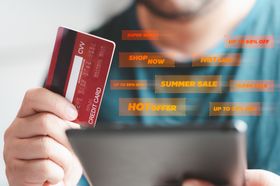7 Critical Online Visual Merchandising Strategies to Drive Your Sales Now
Published October 1, 2024

Today’s online visual merchandiser must be able to incorporate art, science and data to remain competitive in the ever changing online global marketplace. Because online purchasing lacks the physical presence, it must find ways to compensate for the missing shopper sensory input such as touch, smell and taste. The online merchandiser must use advanced techniques of sight and sound selected by data analysis to lure the visitor into a unique, custom tailored shopping experience that compels purchasing behavior. These visual merchandising strategies will help.
Using even just two of these three areas will not be enough to give you the edge you must have to win at this ultra-competitive game, you must have all three. Below we will discuss 7 top performing strategies that can help you elevate sales through creating consumer desire and modifying shopper behavior while on your site.
7 Online Visual Merchandising Strategies
1. You Can’t Just Be Mobile Responsive, You Have to Be Mobile Optimized
There is a reason that even though over half of your traffic may be coming from mobile devices, the majority of your sales may still be coming from desktop.
Recent data shows that an average of 3.35% of consumers checked out while shopping from desktop computers and only 1.18% of smartphone shoppers completed the checkout process.
Data also shows that even though 40% of consumers still don’t feel comfortable shopping online using their desktop, a whopping 80% don’t feel comfortable shopping using mobile devices.
The final solution to this is as unique as your business.
The only way to create the ultimate experience for your customers is through testing.
Yes, you can take cues from other retail environments; however, your niche and customer base most likely won’t react in exactly the same way as they did for brand X in a white paper.
You need to set up a simplified testing environment using A/B testing protocols. Then compile your data on what’s working and what’s not.
The truth is; no one can make a blanket statement about what will work for your business. There are, however, tried and true methods that have outperformed the others time and time again that we will discuss below.
Implement these into your business and test them against your controls. If you’ve not done A/B split testing, you are going to love the insider data that it will provide you, once you get the hang of it.
2. Confused Minds Do Nothing
Fully 18% of non-buyers said that they couldn’t find what they were looking for.
This creates a strong case for evaluating your internal search functions within your site as 11% to 15% of consumers start their shopping by looking for their needs with a site search bar.
One of the best ways to enhance your internal site search is to use a feature that has an autocomplete that actually finds your products.
Also making the search feature prominent, so that the consumer doesn’t have to guess if that’s the search bar or not.
As we spoke of above, confused minds do nothing and as soon as the consumer is unsure of which or what action to take, the preferred action becomes no action, which does not lead to increased sales.
3. Product Pages are Where Online Visual Merchandising Pops
Think of your product pages as mini sales pages because in essence that’s what it is. This is where your customers make their buying decision and add it to their cart.
To start with; you need to make sure they know they have landed on the right page.
Be certain to craft the product name into an alluring headline that tells them this is the one they want and that they made it to the right spot.
Next, use the visual imagery of the main product shot positioned front and center above the fold so they don’t have to scroll to see it. This then, let’s those who don’t read the headline and look at the images first know they are looking at the right product too.
This is just one area where our Drag and drop feature works spectacularly.
You and your staff will finally have complete control over which image shows up first, second, last and even which are hidden.
This feature allows you to ensure they know they are on the right page, the right section and even the right subsection, which as you know keeps visitors engaged because they are actually finding what they are looking for.
This keeps them from hitting the back button and allows them time to decide that they want it.
Along with your headline and image be sure to give your shoppers the information they need to confirm their buying decision.
They will already know they want it. But, information like the description, the price, the specifications such as color, size and measurements allow them to confirm this is the correct item that will fit them, be the right size or the right color.
Social Proof.
Part of that visual seduction is letting the shoppers’ herd mentality become satiated. People don’t want to make a buying mistake and so they look to make sure that others were happy with their purchase to put their mind at ease.
Make your social proof such as a star rating system, testimonials or an as seen on ‘ABC, NBC, CBS, FOX’ type logo set or bar a major visual focus point instead of just an afterthought.
Seeing is Believing.
Be sure to show them instant product color changes when they click on color options, so they can see what your product looks like with those changes.
Show your product from every angle in an active carousel so they can see all the button options if it’s a camera or electronics and see the soles if it’s a pair of shoes.
A few ways to do this are to shoot videos rotating around your product, shoot them with your product in motion or showing your product in use.
For clothing, this may be best accomplished using models as it displays it properly, shows all the angles and shows it in use, all in one video.
4. Treat Returning Shoppers and Repeat Buyers Differently than First Time Shoppers
The biggest reason to do this is that your conversion rates with repeat shoppers and buyers will be significantly greater than with new site visitors.
You’ve already earned their interest or business and trust. This alone indicates that they should be treated differently. After all, you wouldn’t greet an old friend the same way that you greet a stranger.
People like to be remembered. It’s hard-wired into our brains to such an extent that many people feel down or even hurt when a friend forgets their birthday or another special event.
Show your customers that you remember them and stimulate sales at the same time by displaying cookied site responses.
A simple one is to have your system fetch a group of previously viewed items and show them to your returning shoppers or purchasers upon arrival with simple text in the display box such as: Items That Recently Caught Your Eye.
Upon seeing this it reestablishes their memories and trust with you and prompts them to click on one or more of the displayed items that they will have a high probability of placing in their cart, along with the item they returned to your site for.
If your site requires a sign in, then you can take the recently viewed items to the next level for returning members and buyers.
Have the system populate their first name in with the text. An example of which would be: Hi Susan, we hope you’re having a great day. Here are some items that recently caught your eye. Have fun shopping!
You can also use our Merchandising Rules feature that allows you to show, hide or bury products as needed so that the visitors who need to see those products will and the visitors that don’t won’t.
By personalizing it you are taking the place of some of the missing human interaction that is lost online and recognizing people as preferred customers which everyone loves.
5. Court Your High Purchase Intent Shoppers
When you identify people coming to your site with buyer’s intent, you want to court them by optimizing their shopping and purchasing processes to remove as many steps and make it as easy as possible.
One such group are those that are using your internal site search mechanisms. New study we conducted show that your visitors who use your search features actually buy at a 3 times greater rate than those that browse to find what they want.
Another thing that makes searchers such a special sub group of your site visitors is that; in many cases they type the product in by name and also add in parameters like size, color, flavor and other search queries.
When people are at the point where they already know what they want to that type of an extent, they are demonstrating clear buyer intent and are much more likely to make the purchase.
How do you help them buy?
You can either go through the process yourself or create a focus group.
To create the focus group, gather a group of people who are unfamiliar with your site and have them funnel through the entire experience. Have them either take notes or simply record a screen capture video of their actions and reactions.
Have them start with nothing more than your URL and a product name and allow them to go through all the steps and buy it. You can have them return the item or let them keep it and refund them for it.
This is a very cost-effective way to find bottlenecks and trouble spots that need to be eliminated to create the best shopping experience possible.
If you can remove even one step in your process of finding the right product and buying it, then you have really done something.
Then start with the autocomplete of the search feature to make sure that’s optimized, then look at your merchandising and are the products displayed in a way that makes it easy and natural.
Look at your checkout process all the way through to receiving the items.
Was it seamless, painless and were the most relevant products proposed?
If not fix it.
6. Get Personal with Product Recommendations
Test and revamp your internal automatic product recommendations so that they are meeting your shoppers needs.
As you continuously add and remove products this system needs to be tuned up so that it’s running smoothly.
Make sure that if you started shopping for women’s winter boots that it’s retuning items by gender, by season and item type.
Yes, that woman might be interested in ice queen hair picks, but she would more likely be interested in other warm clothing and or outdoor clothing items.
One of the areas that site owners let their product recommendations slide, is in the area of price.
Be sure that your recommendation engine is sending back relevant or items with a slight price increase.
If someone is looking at jackets that cost $200, be sure your engine is not returning jackets priced at $29.99. Have it do similarly priced items with items priced up to the next pricing category of let’s say $299 in this example.
These things dramatically aid in your shopper’s experience and will lead to increased satisfaction, which ultimately leads to higher sales.
7. Better Descriptions Equal More Sales
You have a great product image, now you need a great description as well.
Be sure that it tells them the benefits in such a way as to really show what’s in it for them.
Most people won’t buy what they don’t understand. It goes back to our discussion earlier about ‘confused minds do nothing’.
Product descriptions don’t have to be long, but they do have to be clear.
They must give the customer the information they need to make a purchase.
Very few things can be as aggravating as looking at a garment and not being able to see what the material is made of or what country it was made in.
Likewise, for foodstuffs and health and beauty aids. Who the heck wants to buy a product to ingest or put on their body without being able to see the ingredients. No one, that’s who.
Make sure that your product descriptions not only create desire and sell, but that they provide the critical information that the customer wants before they add to cart.
8. The Job Of the Online Visual Merchandizer
Your task is to do more than color coordinate items so that they look well represented together.
Your job should also be more than that of a pure data analyst. You’re a combination of these things and those we discussed above.







